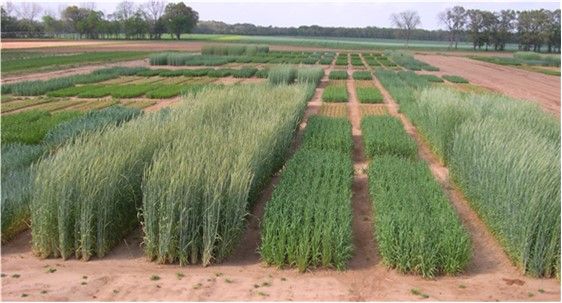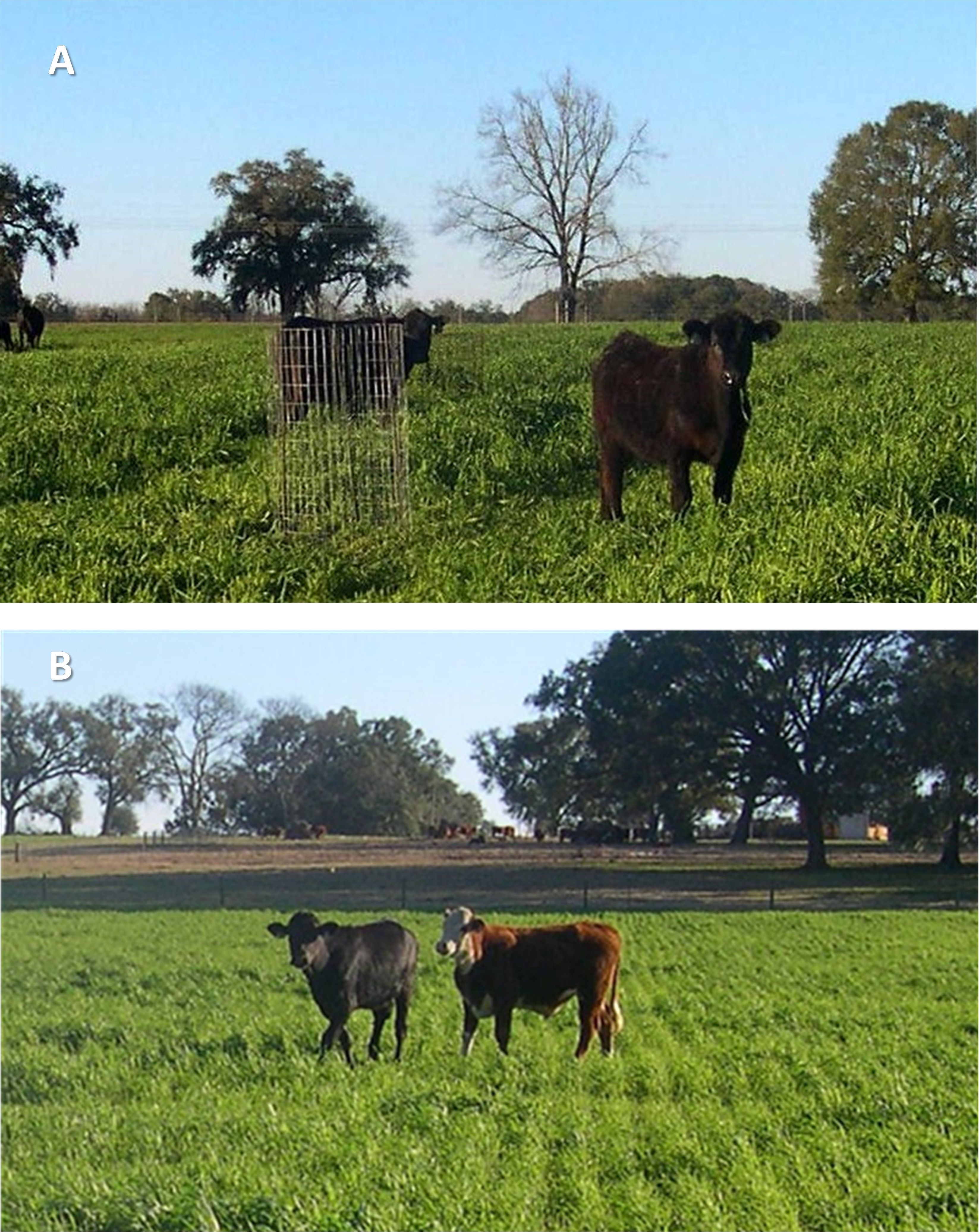Although north Florida has a mild winter climate compared to most of the United States, warm-season perennial forages provide limited grazing from approximately November through March. In contrast, planting annual, cool-season (winter) forages can greatly increase winter grazing options between December and May. Understanding when various winter forages are most productive is important to designing a forage program that best serves livestock and crop enterprises (Table 1; Figure 1). Blends of forage species or even varieties representing different maturities will allow for extended winter grazing and stability of a forage system, particularly until summer pastures renew their growth. The purpose of this publication is to provide guidance on preparing and planting annual cool-season forages on prepared seedbeds and overseeding annual cool-season forages on pastures in north Florida.

Credit: C. Mackowiak
Core Ideas
- A prepared seedbed often provides earlier grazing than an overseeded pasture.
- Greater seeding rates may be required for overseeded pastures.
- A prepared seedbed following bahiagrass requires several weeks for the sod to decompose before winter forages can be planted.
- When overseeding, increase grazing pressure in the spring to reduce winter forage competition with early summer grasses, or choose early-maturing, cool-season varieties.
- Inclusion of winter legumes can help supplement some nitrogen fertilization requirements of warm-season perennial grasses.
Winter Forage Production When Planted on a Prepared Seedbed
For a prepared seedbed, cool-season forages can often be planted a few weeks earlier (mid- to late October; Table 2) than if they are overseeded into a perennial grass sod that has not yet entered winter dormancy (mid- to late November). Small grains are especially desirable for early planting. If planting on a clean-tilled seedbed following permanent bahiagrass (Paspalum notatum Flüggé) or bermudagrass (Cynodon dactylon L.) termination, allow several weeks for plants to decay before planting, as the decaying process will tie up nitrogen (through nitrogen immobilization) needed for growth of the winter annuals.
Table 2 shows planting dates and seeding rates. Early planting on a prepared seedbed often provides earlier grazing than overseeded, perennial grass pastures. However, repeated tillage also tends to reduce soil organic matter. Wallau et al. (2022) provide more detailed information on prepared seedbed preparation.
When deciding which winter forage to grow, review variety trials from state tests and the list of recommended varieties (Wallau et al. 2023). They show differences in yields and time of production (maturity). Early-maturing varieties of wheat, oats, and cereal rye produce more forage early in the winter months when livestock forage needs are critical. Oats offer an advantage because they are the small grains that can often be planted earliest, while rye has the best cold tolerance. However, early planting (i.e., before mid-October) under warm temperatures may result in greater incidence of disease (especially for oats). Additionally, October tends to be one of the driest months in north Florida, resulting in more encounters with drought.
Determining which species of annual winter forages to plant will depend partly on soil type and soil moisture-holding capacity. Rye is a better option for relatively sandier soils, and all small grains will do well on slightly heavier soils. Annual ryegrass performs well on fertile soils with adequate moisture, while crimson clover can tolerate moderately well-drained acid soils. However, annual ryegrass and most clovers perform poorly on non-irrigated, deep sands. Under good soil fertility (Mylavarapu et al. 2021) and irrigation, all small grains, clovers, and annual ryegrass should perform well.
Production of late-season winter forages is also possible. For example, some forages, including annual ryegrass, will continue to grow into May or early June under adequate moisture and moderate (i.e., roughly below 85oF) temperatures. Red and white clovers may continue growing into midsummer in north Florida, if moisture is not limiting.
Overseeding Winter Forages on Bahiagrass or Bermudagrass Pastures
Bahiagrass is the predominant perennial grass in north Florida pastures. Many of these pastures are overseeded with cool-season forages in the fall. In preparation for any overseeding plan, reducing the potential competition of the perennial sod with the overseeded material is paramount. This might entail heavy grazing to a one- or two-inch stubble height, applying a chemical burn down (chemical mowing) to temporarily inhibit sod growth, or waiting until the onset of frost. Overseeding is in reference to the perennial pasture and does not reflect the seeding method. For example, all cool-season forage species can be drilled into the sod but not all forage species seed can be broadcast planted. Generally, large-seeded species, such as small grains, vetch, winter peas, etc., require drilling or tilling into the soil, while small-seeded species, such as annual ryegrass and most clovers, can make good seed/soil contact simply through broadcast planting. The key is to maximize seed/soil contact and ensure the soil contains adequate moisture. Light tillage is a relatively inexpensive method for overseeding into sod but it is not as foolproof as drilling in most cases (unless you misjudge the appropriate drill depth). Since bahiagrass has large rhizomes, more tillage pressure may need to be applied over a bahiagrass sod than a bermudagrass sod, with its thin, spaghetti-like rhizomes. Make sure any tillage or drill method cuts through the organic layer or surface root system (sod) to allow for sufficient contact between the soil and seed. Bahiagrass should be tilled heavily enough that it prevents rapid sod regrowth after planting. If soil disturbance was high through tillage, rolling after planting may be beneficial to increase good seed/soil contact. Note that tillage may cause plant damage and delay and reduce seasonal tonnage from warm-season grasses the following summer, and the resulting soil disturbance through tillage can lessen soil organic matter.
It is difficult to plant and establish cool-season forages before the warm-season, perennial pasture enters dormancy. The later planting date also delays time to initial grazing (often into mid-January). Warm-season grasses vary in winter dormancy onset and duration. Typically, the first strong frost of fall triggers dormancy for most bermudagrasses and ‘Argentine’ bahiagrass. However, ‘Pensacola’ and especially the improved bahiagrass varieties can regreen during periods between frosts, thereby competing with the cool-season forages for water, sunlight, and nutrients. In spring, Argentine bahiagrass and ‘Tifton-85’ bermudagrass are relatively delayed in terms of spring regrowth compared to their counterparts. Combined with late-maturing, cool-season forage species or varieties (especially annual ryegrass), the cool-season forages may delay or even harm warm-season pasture production.
As shown in Table 3, overseeding perennial warm-season grasses with cool-season legumes can offset a moderate portion of mineral N fertilizer inputs. Clovers may contribute approximately 50 lb N/A–200 lb N/A when cool-season growing conditions are good. Depending on the cost of N ($0.90/lb in this example), legumes may produce the equivalent of $45 lb N/A–$180 lb N/A.
Winter legume spring herbage contributions may be roughly 15% to 30% of the total season production, as shown in Table 3 (Evers 1985). This often improves the overall forage quality of a perennial, warm-season grass pasture (Figure 2). However, the cost of establishing legumes can be as much as $30/A–$50/A. Legumes, such as red clover, have more variety options available. For example, ‘Southern Belle’ is non-dormant, which translates into earlier production and therefore longer seasonal grazing than some other red clover varieties.

Credit: C. Mackowiak
Florida’s frequently dry fall often discourages producers from overseeding pastures because a lack of soil moisture coupled with warm temperatures can cause stand failures to occur. Adequate rainfall is key to the success of any winter forage program. Additionally, exceedingly cold (i.e., frost and freeze) temperature events can delay the growth of cool-season forages and result in cold damage and sometimes even death of young, tender plants.
Take-Home Goals
- Use open land or areas that have been previously cropped to prepare a seedbed for early grazing (mid- to late December). Use a chisel plow to break the soil compaction layer, if needed, for better root penetration by cool-season forages.
- Select proper forage species and varieties that are productive when grazing is needed.
- When planning for forage species or variety mixtures, aim for plant combinations that result in a more evenly distributed forage production period across the cool season and match grazing needs. Forage mixtures also tend to add resilience to unexpected changes in growing conditions.
- Perform a soil test and apply proper nutrients early (first application prior to tillering) to ensure optimal forage growth (Mylavarapu et al. 2021). If legumes are to be planted (including when mixed with other forages), check soil pH and apply lime two or more months ahead of planting, if needed.
- Wait for adequate soil moisture before planting to ensure good seed germination and seedling emergence. Plant annual winter forages in the early part of the seeding date range if using a prepared seedbed. If overseeding bermudagrass, delay planting until the last half of the seeding date range. When overseeding bahiagrass, delay the planting date another two to three weeks, unless the grass is dormant (Figure 3).
- When planting legumes, apply the proper inoculant (or plant pre-inoculated, coated seed) to ensure proper legume-N2 fixing bacteria specificity (Wright et al. 2018).
- Many producers use a no-till drill with good results on bahiagrass sod. No-till drills are sometimes available for rent through the local soil conservation district or seed/fertilizer dealer. Drills differ in the degree of tillage or sod disturbance. Cutting coulters can vary in how aggressively they disturb the sod, ranging from non-fluted or straight to aggressively fluted blades (i.e., turbo coulter blades). Some have alternatively used a harrow that is offset by 30 degrees or less, followed by a conventional drill. No-till drills have become increasingly popular. Some federal and state agency conservation or best management practice (BMP) programs will provide cost-share for no-till drill purchases as well as cover crop seed. To learn more, contact your local UF/IFAS Extension office. There are many different no-till drills on the market. Consequently, consulting with someone who is experienced with no-till drills and who knows how and where to use them can be quite valuable. Most no-till drills perform well if planting depth is correctly set, moisture is adequate, and the sod is cut or grazed short before planting.
- Do not graze winter forage too early or aggressively, as it will result in stand loss. Most small grains should not be grazed before 12 inches, nor should they be closer than a 3-inch stubble height.
- Consult with your local UF/IFAS Extension office for updates on the best winter forage selections and management practices available to you.

Credit: C. Mackowiak
References
Dubeux, J., M. Wallau, E. Rios, Y. C. Newman, P. Munoz, and K. Quesenberry. 2022. “Winter Forage Legume Guide.” SS-AGR-49. Gainesville: University of Florida Institute of Food and Agricultural Sciences. https://edis.ifas.ufl.edu/publication/DS127
Evers, G. W. 1985. “Forage and Nitrogen Contributions of Arrowleaf and Subterranean Clovers Overseeded on Bermudagrass and Bahiagrass.” Agronomy Journal 77:960–963. https://doi.org/10.2134/agronj1985.00021962007700060030x
Mylavarapu, R., D. Wright, and G. Kidder. 2021. “UF/IFAS Standardized Fertilization Recommendations for Agronomic Crops: SS163/SL129, rev. 10/2021.” EDIS 2021 (5). https://doi.org/10.32473/edis-ss163-2021
Wallau, M., A. R. Blount, E. Rios, J. M. B. Vendramini, J. C. B. Dubeux, Md. A. Babar, K. E. Kenworthy, M. Mulvaney, and K. H. Quesenberry. 2023. “2023 Cool-Season Forage Variety Recommendations for Florida: SS-AGR-84/AA266, rev. 8/2023.” EDIS 2023 (4). https://doi.org/10.32473/edis-aa266-2023
Wallau, M. O., J. Vendramini, and E. Jennings. 2022. “Forage Planting and Establishment Methods on Prepared Seedbed: SS-AGR-161/AG107, rev. 1/2022.” EDIS 2022 (1). https://doi.org/10.32473/edis-ag107-2022
Wright, D. L., C. Mackowiak, I. Small, and A. Blount. 2022. “Inoculation of Agronomic and Forage Crop Legumes.” SS-AGR-154. Gainesville: University of Florida Institute of Food and Agricultural Sciences. https://edis.ifas.ufl.edu/publication/AA126
Table 1. Forage production periods for several cool-season forages recommended for north Florida.
Table 2. Winter forage seeding dates and rates.
Table 3Z. Total herbage production of bermudagrass and bahiagrass alone or with two overseeded clovers.